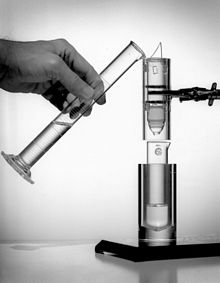 The first technetium-99m generator, 1958. A 99mTc pertechnetate solution is being eluted from 99Mo molybdate bound to a chromatographic substrate | |
| General | |
|---|---|
| Symbol | 99mTc |
| Names | technetium-99m, 99mTc, Tc-99m |
| Protons (Z) | 43 |
| Neutrons (N) | 56 |
| Nuclide data | |
| Half-life (t1/2) | 6.0067 h[1] |
| Isotope mass | 98.9063 Da |
| Spin | 1/2− |
| Excess energy | −87327.195 keV |
| Binding energy | 8613.603 keV |
| Parent isotopes | 99Mo (65.976 h) |
| Decay products | 99Tc |
| Decay modes | |
| Decay mode | Decay energy (MeV) |
| Isomeric transition γ emission 87.87% | 98.6%: 0.1405 MeV 1.4%: 0.1426 |
| Isotopes of technetium Complete table of nuclides | |
Technetium-99m (99mTc) is a metastable nuclear isomer of technetium-99 (itself an isotope of technetium), symbolized as 99mTc, that is used in tens of millions of medical diagnostic procedures annually, making it the most commonly used medical radioisotope in the world.
Technetium-99m is used as a radioactive tracer and can be detected in the body by medical equipment (gamma cameras). It is well suited to the role, because it emits readily detectable gamma rays with a photon energy of 140 keV (these 8.8 pm photons are about the same wavelength as emitted by conventional X-ray diagnostic equipment) and its half-life for gamma emission is 6.0058 hours (meaning 93.7% of it decays to 99Tc in 24 hours). The relatively "short" physical half-life of the isotope and its biological half-life of 1 day (in terms of human activity and metabolism) allows for scanning procedures which collect data rapidly but keep total patient radiation exposure low. The same characteristics make the isotope unsuitable for therapeutic use.
Technetium-99m was discovered as a product of cyclotron bombardment of molybdenum. This procedure produced molybdenum-99, a radionuclide with a longer half-life (2.75 days), which decays to 99mTc. This longer decay time allows for 99Mo to be shipped to medical facilities, where 99mTc is extracted from the sample as it is produced. In turn, 99Mo is usually created commercially by fission of highly enriched uranium in a small number of research and material testing nuclear reactors in several countries.
- ^ "99mTc tables" (PDF). Nucleide.org. Laboratoire National Henri Becquerel. 17 January 2012. Archived from the original (PDF) on 4 August 2016. Retrieved 23 May 2012.